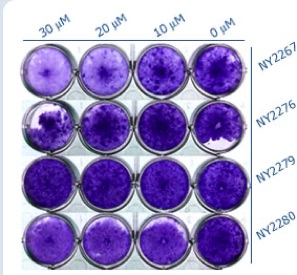Combinatorial Chemistry & Polymer Synthesis
Starting with our work into the development of soluble polymers for use in organic synthesis, we have made numerous contributions to the area of combinatorial chemistry and polymer design. By replacing insoluble cross-linked resins with soluble polymer supports, the familiar reaction conditions of classical organic chemistry are reinstated, yet product purification is still facilitated through application of macromolecular properties. This methodology, termed liquid-phase synthesis, in essence avoids the difficulties of solid-phase synthesis while preserving many of its advantages. For example, standard spectroscopic techniques such as 1H and 13C NMR may be used directly on samples without special equipment (e.g., MAS probes). Furthermore, even methods such as TLC can be used for monitoring soluble polymer-supported reactions. Our studies have focused on two distinct polymeric supports, poly(ethylene glycol) (PEG) and non-cross-linked polystyrene (NCPS). Our most recent efforts in the use of soluble polymers have focused on the ability of PEG ester of tartaric acid to serve as catalysts for the Sharpless asymmetric epoxidation (AE) reaction. Amazingly, without changing the chirality of the tartrate, one can reverse the enantioselectivity of this reaction simply by changing the molecular weight of the appended polymer. The enantioreversal was proposed to occur as a result of two Ti:ligand complexes which differ in their molecularity of ligand, one monomeric in ligand and the other dimeric. Support for this hypothesis was given through equilibrium measurements which revealed that the predominant species in Ti:PEG tartrate ester mixtures is a distinct 2:1 Ti:ligand complex, as opposed to the 2:2 Ti:ligand complex of traditional Sharpless asymmetric epoxidations. In total, this data represents an unrecognized property of PEG-supported catalysts that could open up new venues in the control of asymmetric reactions by means of achiral appended polymers.
Solid-phase organic synthesis (SPOS) has become a powerful methodology for the generation of compound libraries. However, the success of this technique is highly dependent on the accessibility of the functional sites of the polymer to reagents. Concurrent with the resurgence in solid phase synthesis has been the recognition that chemical reactivity of a supported small molecule, catalyst, or reagent may be significantly altered by so-called "polymer effects," the origins of which may be physical or chemical. Thus, it is no longer reasonable to depict the polymer matrix as a simple ball or to consider the support as a rigid inert material. The support interacts with the surrounding medium and can impact the kinetics of the reaction, clearly implicating it as more than a simple bystander. As such, in developing synthetic routes to molecules on a gel-phase support, one must consider not only the functional group distribution along the polymer chain, but also the three-dimensional arrangement of the anchored functional groups. Additionally, the nature of the polymer backbone must also be considered as the composition of the support can have a pronounced impact on the success of a chemical synthesis.
Styrene-based polymers remain the most widely used supports in SPOS. Mainly, this is due to their ready availability and proven use in the field of Merrifield polypeptide synthesis. Additionally, the development of new resins that are economically viable, exhibit satisfactory physical characteristics, and are inert to a diverse range of reagents or catalysts is a significant undertaking, and as such, Merrifield resins have remained the gold standard for SPOS. However, it has been recognized that while tailoring new gel-based resins is nontrivial, new resins will be needed if the field of SPOS continues to grow. Strategies to identify polymeric supports that are more suitable for SPOS have included the reformatting of the divinylbenzene polystyrene resins (DVB-PS); the addition of either poly(ethylene glycol) (PEG), polystyrene, or hydrocarbon grafts to DVB-PS resins; the use of macroporous polystyrene- or PEG- based matrices; and the grafting of polystyrene onto polypropylene or Teflon surfaces.
A different approach that has recently emerged involves the replacement of divinylbenzene (DVB) as the cross-linker in polystyrene resins with a more flexible molecule. Recently, we introduced resins based on flexible polytetrahydrofuran (PTHF) cross-linkers, termed JandaJels™. Our efforts using this resin type have revealed several significant advantages to these supports including the ease of preparation of a highly pure cross-linker which translates into a more homogeneous resin and improved chemical stability relative to flexible cross-linker counterparts containing PEG. Indeed, through the use of various spectroscopic techniques including fluorescence spectroscopy and diffusion-ordered NMR spectroscopy (DOSY), we have proven that the internal microenvironment of JandaJels is more "solution-like" than the corresponding Merrifield resins.
We have since used JandaJels in a variety of synthetic strategies including library synthesis, as a support for catalysts and reagents, and in the preparation of a variety of heterocyclic compounds using rhodium insertion methodologies. Research into the development of other novel resins suitable for use by the synthetic chemist are ongoing in the laboratory and we continue to aim for the development of a "toolbox" of resins accessible to all chemists that can allow the facile implementation of traditional solution-phase reactions in SPOS.

